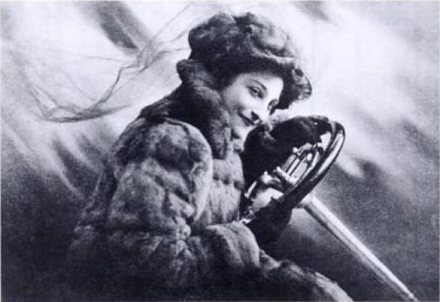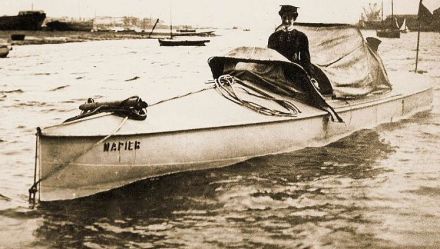As the 19th Century drew to a close the Levi family, members of London’s Sephardi Jewish community, enjoyed a prosperous lifestyle. The head of family, Jacob, ran a thriving tea merchant’s business and, together with his wife Julia, he raised two beautiful daughters to enjoy the finer things in life and to take part in active pursuits.
The elder and more adventurous of the girls, Dorothy, was born in Hackney in 1882 and became a noted horsewoman. By the time she was 18 her father, who was known as Jack to most anyway, chose to Anglicize the family name to Levitt and soon afterwards Miss Dorothy Levitt began the most exciting chapter of her life.
Dorothy became a secretary at the engineering firm Napier & Son, which had recently begun to forge a reputation in the new and exciting world of internal combustion engines. Ever unconventional, Dorothy was known about town to be an independent, privileged, “bachelor girl”, living with friends in the West End of London and waited on by two servants.
This elegant and confident young woman stood out a mile from the rest of the secretaries, even at a company as extraordinary as Napier. Before long Dorothy caught the attention of Montagu Napier’s swashbuckling partner in the engine building business, Selwyn Edge.
The burly Australian self-publicist Edge, with his magnificent cad-like moustache and larger-than-life persona, decided that this exotic young beauty was wasted behind a typewriter and would better serve Napier’s fortunes as the public face of the company. Thus he devoted himself to making her a walking, talking advert for Napier products – apprenticing her in car production and maintenance while teaching her to drive with the same verve that he applied to his own motor racing career.
While Dorothy got to grips with driving motor cars, Edge was taking Napier & Son onto the high seas. Motor boats were a new phenomenon and Edge desperately wanted to be a part of it – all the more so when Sir Alfred Harmsworth’s Daily Mail newspaper inaugurated a new race for motor boats, the Harmsworth Trophy, as a means of encouraging the development of a new motorised torpedo craft for the Royal Navy.
Officiated by the Automobile Club of Great Britain and Ireland and the Royal Victoria Yacht Club, the Harmsworth Trophy took place at the Royal Cork Yacht Club at Queenstown (now Cobh) on Sunday 12 July 1903. The rules were very simple: competitors were to build craft specified to be of a maximum 40 ft waterline length and using any appropriate form of power.
In these the crews would race on an eight-and-a-half mile course from the Club down to the Marina. The magnificent trophy depicted a relief of how Harmsworth believed the victorious boat would look – but more important still were the kudos and the military contracts that seemed assured to the winning entry.
In the end only three boats were lined up at the start, among which all the pre-race talk was focused on the ebullient Mr. Selwyn Edge and his Napier craft. This was a 40ft steel-hulled, speedboat fitted with a 3-blade propeller that was driven by a derivative of Napier’s brilliant automobile engine – but it was the crew which captured most attention.
Edge was named as entrant and skipper, and alongside him was listed Mr. Campbell Muir but it was the third crew member around whom the interest was focused: Miss Dorothy Levitt. Very little of this interest was made official, because women were not recognised as competitors, but Edge made damned sure that his girl took centre stage throughout the three days of the event and milked her presence as hard as he could.
The Cork Constitution made for breathless reading on 13 July, when it reported: “A large number of spectators viewed the first mile from the promenade of the Yacht Club, and at Cork several thousand people collected at both side of the river to see the finishes.
“Owing to the starters and the judges not being in communication by telephonic or any other means, people at either end of the course could only conjecture the result.” The result was victory for Napier, which attained the fantastical speed of 19.3mph after the company’s 50hp motor was suitably upgraded to 75hp in racing trim.
The name S.F. Edge was duly engraved as the inaugural winner on the Harmsworth Trophy, although it was officially recorded that Campbell Muir had done the driving. What the many thousands of onlookers saw, however, was the raven-haired young girl standing at the tiller as she guided the brilliant white-painted boat to victory.
Napier’s marine credentials were duly established, while the race itself passed into legend, courtesy of Dorothy Levitt. Four weeks later another race for powered craft was staged at Cowes during the annual sailing regatta, and once again it was the Napier boat which scythed to victory with its glamorous helmswoman soaking up the attention.
This time Dorothy achieved all the official recognition that she could hope for – and then some. After crossing the line for victory, she was commanded to board the Royal yacht Victoria & Albert III for an audience with King Edward VII where it was recorded that his majesty congratulated her on her pluck and skill before they discussed the performance of the boat and its potential for British government despatch work.
Capitalising on the phenomenon that he had created, Edge entered his Napier boat in the French answer to the Harmsworth Trophy – the five-mile Gaston Menier Cup at Trouville – later in August. Of course Dorothy Levitt was on board and, once again, the Napier claimed the honours – and with it a ₤1000 purse – while France fell under Miss Levitt’s spell.
Dorothy was to make one more appearance on behalf of Napier’s marine business when the team returned to Trouville that October for the Championship of the Seas race. Napier triumphed once again and, while Dorothy soaked up the adulation, the French government bought the boat from Edge for £1,000.
It was a case of ‘Mission: Accomplished’ for this remarkable young woman – although her career was only just getting started. See you for Part 2 in due course!


